This article is focused on the best rotary pedals on the market. We have a separate article about Uni-Vibe pedals, which are also Leslie-inspired. Most multi-modulation pedals also feature a Rotary/Leslie mode.

Please use our affiliate links (Sweetwater, Reverb.com, Amazon…) that’s what’s allowing us to keep this site alive at no cost to you!
Updated on August 03, 2021
A Shopping Guide to the Best Rotary Pedals and Leslie Emulations
Those who are not too familiar with the sound of the Rotary (or Leslie) speaker may want to expand the section below for a quick recap with some sonic examples. A more in-depth history of this effect can be found here.
What Is a Rotary Speaker?
| Click here to expand/shrink this section |
—
Our Five Categories
After some thought, we decided to organize the current rotary pedal market offerings into six categories.
The No-Frills section features affordable stompboxes that offer convincing Leslie tones at the press of a button, but they are all mono and lack features. The pedals in the Mono Leslie Simulators list are still mono but go further than the previous entries, giving you control over slow and fast speeds, a natural-sounding ramp up and down as you change between them, and other niceties. The Stereo Rotary Pedals go for ultimate realism and mimic the characteristics of true Leslies both for the stereo sound and features like tube overdrive, virtual microphones with distance control, and so on.
We also included a list of Vintage Models featuring valued discontinued pedals that deliver an inspired take on the classic Uni-Vibe, and one with a selection of stompboxes that combine Rotary with other effects.
So much for the explanations. Let’s get this round-up in motion
NO-FRILLS ROTARY PEDALS
If you want convincing rotary tones in an easy-to-use pedal, the units in this list should do the trick.
Click/tap on the thumbnails to see a video of each pedal.

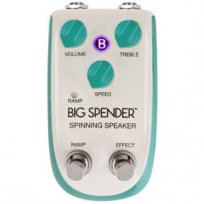
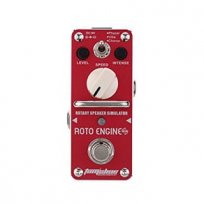
For those with a decent budget, the Neo Mini Vent II is the way to go. Neo turned a lot of heads a few years back with its Ventilator, a desktop Leslie emulator designed for organists. Since then, the company has placed that circuitry in the guitarist-friendly Ventilator II (see below under Deluxe Emulators) and the Mini Vent II, a simple little box that gives you just what you need for convincing Leslie tones both in mono and stereo. Voiced after a 122 model rotary cabinet, it has a separate footswitch to ramp up the speed and a Distance knob that lets you move the virtual microphones closer for a more intense effect or further for a more diffuse one. Speed or Mix can be controlled via Expression Pedal.
With Chorus and Vibrato settings, the Mooer Soul Shiver seems like a Uni-Vibe clone until you kick it into Rotary mode, where it delivers shimmering Leslie-like tones. It costs around 1/8th of the previous pedal, and it’s a lot smaller too!
The Tomsline Roto Engine is a similar beast, a mini pedal with modes for Chorus, Phaser and Vibe. There aren’t many videos of the pedal in action, but the two we found convinced us that it’s more than a Uni-Vibe clone, delivering suitably watery rotary tones that might make your audience think you’re using a real Leslie cabinet.
For a little more control, there is the Danelectro Big Spender, a popular entry in the company’s now discontinued Billionaire series, a Leslie simulator that features Chorale and Tremolo modes with a ramp control.
Finally, the TC Vibraclone is part of the Danish company’s super-affordable recent batch of pedals. It has a fixed Mix (dry/wet) ratio and, notwithstanding its popularity, gets mixed reviews.
ADVANCED MONO LESLIE/ROTARY PEDALS
The pedals in this category deliver convincing Leslie simulations in mono, along with a feature-rich set of controls, including horn/bass rotor balance or microphone emulation.
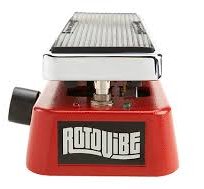

The Dunlop Rotovibe is a sturdy, original take executed in a no-frills fashion, although the treadle-based approach controlling the effect’s intensity makes it stand apart from the competition.
The Keeley Dyno My Roto is both a Leslie simulator and a chorus and flange pedal. It has a Proximity Control to impart mic-and-cabinet emulation. Its mono output and lack of ramp control prevent it from being a full-on Leslie simulator, but, as the video demonstrates, it sounds fantastic.
The Fulltone Mini DejaVibe Mk II is a popular, 18-volt, re-engineered, smaller but mono version of the original, now out of production. It keeps the signature big Speed knob that can be turned by foot. A 3-way mini-toggle switches between the original Uni-Vibe warmth and a “Modern” option (louder, brighter). There’s also a custom version of this circuit called MDV-3 Mini Deja-Vibe, which features a treadle.
The Neo Micro Vent 122 is a two-speed, mono, rotary pedal that packs the features of the well-received, high-end Ventilator in a compact case. The Distance knob simulates the sound of a microphone at closer or farther positions from the cabinet. Holding the footswitch ramps up the speed.
ADVANCED STEREO ROTARY/LESLIE PEDALS
Technically it can’t be said that the original rotary effect was in stereo, but since it was created by an actual, 3D rotating speaker, it definitely sounded stereo to anyone sporting two functioning ears. If you’re all about the Leslie effect, you can’t do better than these effects.
The DigiTech Ventura Vibe manages to fit stereo versions of two Uni-Vibe and one Rotary mode in a compact case, and it’s by far the most popular pedal in this article. It features stacked tone and drive knobs and a useful Mix control – plus Speed and Depth knobs. A toggle switches between the 3 effect varieties. It also has expression pedal input.
The more recent Electro-Harmonix Lester G (also stereo) features a specially designed compression circuit to supercharge the rotating speaker effect on guitar. Controls include fully adjustable tube-style overdrive, Fast and Slow modes and an Acceleration control to dial in the rate at which the effect transitions between speeds.
The stereo Strymon Lex is simpler than it looks, with four tone shaping knobs: Fast Rotor Speed, Preamp Drive, Mic Distance, Horn Level. Four “hidden” knobs allow extensive tone tweaking: Slow Rotor Speed, Cab Direction, Acceleration Time, +/- 6dB Boost/Cut. Selectable Cab Filter and dedicated speed ramp footswitch are useful extras.
Employing COSM-modeling technology, the BOSS RT-20 is slightly old in the tooth but still a popular stereo pedal, offering adjustable Rise Time, Horn and Bass speed, Overdrive, and more. It can also be used to create unique overdrive and pulsating effects. It offers a cool graphical view of the virtual rotors on its built-in display.
Neo Instruments was among the pioneers in this field, blowing everyone away with the Ventilator, a desktop-style pedal that emulates the Leslie 122, one of the most famous cabinets in the company’s historic lineup. While the Ventilator’s feature set is no richer than what’s offered on some pedals in the Leslie Emulator category, the quality of its emulation is truly exceptional, with a depth of realism that few can match. For guitarists, Neo created the Ventilator II, which offers the same features in a smaller format, along with expression pedal control.
The Fender Pinwheel delivers three different rotary speaker voices, including Fender’s own Vibratone effect, switchable Slow and Fast speeds, and an onboard Overdrive for added texture. The Sensitivity control allows modulation rate changes based on your playing dynamics. Selectable guitar and keyboard voicings
Dawner Prince recently came out with a stereo open cabinet revolving speaker emulator called Pulse, inspired by Pink Floyd’s legendary rotary speaker Doppola and Maestro Rover RO-1. It has separate controls for slow and fast rotation speed and a mix control. Inertia knob sets the time it takes for the ramping effect to go from slow to fast, while the Distance knob mimics the distance of the virtual microphone from the speaker.
RELEVANT DISCONTINUED ROTARY PEDALS
Fifty years since its debut, the Uni-Vibe remains a quintessential modulation effect – and one of the most popular pedals, see our comprehensive list of Uni-Vibe stompboxes. Recreations of the original effect make up the bulk of our vintage category and include the Fulltone Mini Dejávibe, the Voodoo Lab Micro Vibe, the BBE Soul Vibe.


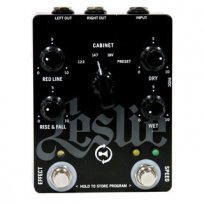
More recently discontinued pedals that sell for noteworthy amounts on the used market are the Pigtronix Rototron and the Tech 21 Roto Choir.
As of 2020, the Leslie G is also discontinued, Hammond’s own entry in the rotary-speaker emulation market for guitarists. The pedal is a smaller version of its Digital Leslie Pedal. That unit features emulations of the 122, 147, and 18 model cabinets, as well as the Hammond PR-40 tone cabinet, a stationary-speaker cabinet that was a standard issue with Hammond organs in the 1950s and 1960s. (The addition isn’t surprising when considering that Leslie is now marketed under Hammond.) The Leslie G loses the PR-40 emulation, which is no great loss, and instead lets you store a preset or your own creation.
ROTARY PEDALS WITH EXTRA EFFECTS
We were a little hard-pressed to figure out where to put these entries. They are rotary-speaker simulators but they include additional features that make them neither Uni-Vibe clones nor No-Frills pedals. Rather than let them get lost in the shuffle, we decided to reward their uniqueness by giving them their own category.
The Monterey Rotary Fuzz Vibe produces rotary-speaker tones but also has fuzz and octave up/down circuitry, so it’s considerably more than a rotary-style effect.
The NUX Roctary, on the other hand marries a rather deep Rotary effect simulation with two-octave effects (one up, one down). It features two-speed knobs, a dedicated ramp footswitch, a Bass-Horn control, and the always useful Blend knob.
—
THE HISTORY OF THE ROTARY SPEAKER
The rotary speaker was created in the late 1930s by Donald Leslie, a repairman at Barker Brothers Department Store in Los Angeles, which sold and serviced Hammond organs. Leslie was unhappy with the organ’s static sound and deduced that pipe organs sound so good because their pipes are stacked side by side, usually in a staggered arrangement and sometimes even split into separate divisions placed several feet apart. He figured the best way to emulate this was to scatter the sound so it wasn’t emanating from one place.
Leslie set out to create a “moving” speaker that would rotate on its axis and throw the sound as it spun. His original design used a spinning treble horn, but he later improved on it by employing a crossover circuit to split the high frequencies, which went to the horn, from the low frequencies, which were fed to a large speaker that faced downward into a rotating drum-shaped baffle. Though his early cabinet had one speed—Tremolo (fast)—he later created a slower speed, called Chorale, so that the sound was always in motion.
While Leslie has gone down in history for his creation, it appears that the Allen Organ Company was marketing a cabinet based on the idea at the same time or possibly slightly before him. The Gyrophonic Projector, as it was called, was designed to work only with Allen organs. According to one description, it featured three 12-inch loudspeakers and three 3-inch tweeters mounted on a vertically rotating wood disc—obviously not as tidy a design as Leslie’s and perhaps the reason why it never caught on. You can see a modified example in the video below, with a guitar used in the demonstration.
HOW IT WORKS
Rotary speakers exploit the Doppler effect, which causes the pitch and volume of a fast-approaching object, such as a police siren, to rise as it nears the listener and lowers once it passes and recedes. As the Leslie’s rotary speakers spin, they cause the pitch of the sound produced through them to waver slightly but perceptibly as the horn and speaker baffle spin toward and away from the listener. At the same time, the volume fluctuates gently. Together, this creates a fluid shift in pitch and volume, effects that we know as vibrato (pitch modulation) and tremolo (amplitude modulation).
But recreating this effect electronically isn’t as easy as combining vibrato and tremolo. The physical dynamics of a true rotary speaker are complex and difficult to emulate. Digital signal processing (DSP) has made it possible to create convincing emulations of the effect, but that’s not to say earlier analog attempts at mimicking the Leslie were failures. Far from it. The Uni-Vibe did a good job of copying the rotary speaker’s watery tremulousness, and it remains a desirable effect in and of itself even as convincing rotary emulations have come to market.





























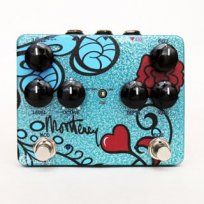









3 comments
JJJohnson says:
Dec 18, 2020
Thanks for all the info on helping me decide on which pedal to buy
Jay says:
Jun 24, 2021
You’ve missed one of the best Leslie pedals.
The NUX Rocktary. Not as good as the Neo Vent, but Raquel with the Lex..
Jay says:
Jun 24, 2021
You’ve missed one of the best Leslie pedals.
The NUX Rocktary. Not as good as the Neo Vent, but equal with the Lex..